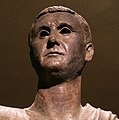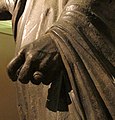Aule Metele and The Orator: Difference between pages
Appearance
(Difference between pages)
Content deleted Content added
No edit summary |
Moved content from "Aule Metele" page |
||
| Line 28: | Line 28: | ||
==References== |
==References== |
||
{{reflist}} |
{{reflist}} |
||
{{Empty section|date=February 2013}} |
|||
==Bibliography== |
|||
Revision as of 04:59, 24 May 2015
| The Orator | |
|---|---|
 | |
| Year | c. 100 BCE |
| Medium | bronze |
| Dimensions | 179 cm (70 in) |
| Location | National Archaeological Museum, Florence |
Aule Metele, Latin: Aulus Metellus; also known as The Orator, Italian: L'Arringatore, is a bronze sculpture 179 cm high.[1] It is a Romano-Etruscan work from the late second century or early first century BCE in the Roman style and depicts an Etruscan man, Aule Metele, wearing a short Roman toga and footwear. His right arm is raised to indicate that he is an orator addressing the public.[2]
The retrograde inscription is in the Etruscan alphabet reads: : “auleśi meteliś ve[luś] vesial clenśi / cen flereś tece sanśl tenine / tu θineś χisvlicś” (“To (or from) Auli Meteli, the son of Vel and Vesi, Tenine (?) set up this statue as a votive offering to Sans, by deliberation of the people”).[3][4]
-
Detail of inscription
-
Detail of inscription
-
Detail of head
-
Detail of left hand
References
- ^ Larissa Bonfante (1986). Etruscan Life and Afterlife: A Handbook of Etruscan Studies. Wayne State University Press. pp. 139–. ISBN 0-8143-1813-4.
- ^ Horst Woldemar Janson; Anthony F. Janson (2004). History of Art: The Western Tradition. Prentice Hall Professional. pp. 190–. ISBN 978-0-13-182895-7.
- ^ TLE 651; CIE 4196
- ^ Koen Wylin (2000). Il verbo etrusco: ricerca morfosintattica delle forme usate in funzione verbale. L'ERMA di BRETSCHNEIDER. pp. 112–. ISBN 978-88-8265-084-1.




